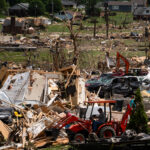Firefighters are still working on containing two of the fires burning in Southern California. In the past five days, more than 42,000 acres have burned, and close to 1,000 properties have been destroyed, according to CAL Fire. While experts say it is too soon to tally insured losses, fires at this time of year are not unusual, according to Neena Saith, catastrophe response manager of Risk Management Solutions (RMS).
In fact, Saith said this spate of fires is just behind the “peak” of the wildfire season in October, a time when many of the most notorious California wildfires have occurred, including the 2007 and 2003 southern California outbreaks and the Oakland Hills Wildfires in 1991. As in 2007’s fires, the driving force for the past week’s fires was the onset of the Santa Ana Winds, combined with warm temperatures (between 90 to 94 degrees) and low humidity that kicked in last week, she said.
Dr. Tomas Girnius, senior research scientist at AIR Worldwide, a catastrophe risk modeling firm, agreed. Girnius said, “Wind gusts peaked to over 70 mph on Saturday, and the hot air flow from inland deserts set numerous high temperature records across California as the fires swept over tinder-dry chaparral — the highly flammable mix of stunted trees and bushes commonly found in Southern California — and brush vegetation.” He noted that calmer winds and cooler temperatures provided some relief to firefighters in the past couple of days.
Despite the easing winds, fire officials are still concerned about the unseasonably high temperatures and low humidity affecting the region today. “Another round of weak Santa Ana winds may arrive by Friday or Saturday but these winds should not approach the strength of the earlier Santa Anas and are not forecast to pose a significant fire threat,” Girnius added. “While the situation on the ground seems to have stabilized substantially and the diminished winds have aided firefighting efforts, the reported perimeters of the fires continue to be refined.”
As of press time, following is the status of the three fires.
*The Tea Fire – Began in Santa Barbara county near Montecito on November 13 and burnt a total of 1,940 acres, destroying at least 210 residences and damaging nine residences. Montecito is among the wealthiest communities in the United States and many of the approximately 4,000 residences are multi-million dollar mansions. Westmont College suffered a direct hit from the blaze, with at least four college buildings significantly damaged or lost, and another 12 faculty houses were destroyed. Cal Fire reported the Tea Fire was 100 percent contained at press time.
*The Sayre Fire – Began in Los Angeles County in Sylmare on November 14 and has burnt a total of 11,207 acres to date. The Sayre Fire is the most damaging of the three fires so far and has damaged/destroyed approximately 615 structures. The most devastating damage occurred at the Oakridge Mobile Home Park, where the wood, aluminum siding, and tar roofs of the modular homes provided ready fuel for the fire. This incident prompted California Governor Arnold Schwarzenegger to call for changes in building codes to better protect mobile homes in future wildfires. As of press time, the Sayre Fire was 85 percent contained.
*The Freeway Complex Fire – Began in Riverside County on November 15, quickly spread to Orange County, and has burnt a total of 28,889 acres. This is the biggest fire in terms of acreage burned; however, it has destroyed the least number of properties so far. Only 151 residences have been destroyed by the fire, of which 113 are located in Yorba Linda and 31 in Anaheim. An additional 104 residences have been damaged. As of press time, the Freeway Complex Fire was 90 percent contained. However, as the Santa Ana winds have died down significantly, firefighters are making good progress in containing the fire.
The causes of the three fires remain unknown, but human involvement remains a possibility in all three cases.
ISO estimates that fire losses associated with homeowners insurance claims (including FAIR Plans) accounted for 58 percent of total insured fire losses in 2007. Fire losses associated with commercial multiple peril and fire insurance claims each accounted for 21 percent of total insured fire losses in 2007, according to the Insurance Information Institute.
Sources: Air Worldwide, Cal Fire, III, RMS
Was this article valuable?
Here are more articles you may enjoy.

 Will Workers’ Comp Benefit from ‘Most-Favored-Nation’ Drug Pricing?
Will Workers’ Comp Benefit from ‘Most-Favored-Nation’ Drug Pricing?  Report Shows Cargo Theft Risk at All-Time Highs as Memorial Day Weekend Nears
Report Shows Cargo Theft Risk at All-Time Highs as Memorial Day Weekend Nears  Trump Administration Targets Resiliency Funds to Shrink FEMA’s Role
Trump Administration Targets Resiliency Funds to Shrink FEMA’s Role  Cyberattack Surge Creates Opportunity, Premium Rethink for Insurers
Cyberattack Surge Creates Opportunity, Premium Rethink for Insurers 